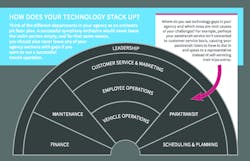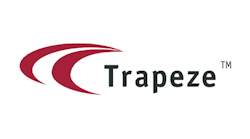The C Suite Unplugged: Do You Have What it Takes to Orchestrate a Transit Masterpiece?
Earlier this summer, I wrote an article for Mass Transit Magazine about the three primary issues that are keeping transit CEOs up at night: aging infrastructure, decreasing ridership and paratransit cost escalation. These burning issues are keeping many from creating a transit masterpiece in their city.
How can you successfully address these pain points and start to move onto proactive improvements for your transit system? It involves performing a root cause analysis of each of these issues and then designing and implementing an appropriate strategy to overcome the root causes.
For example, in almost every city in America, the cost of providing ADA paratransit service is escalating faster than the increases in the transit system’s annual appropriations. Therefore, in every major transit system there are conversations just like this one going on now — imagine this scenario:
A transit CEO meets with his/her CIO, CFO, and COO about paratransit cost escalation — the CEO wants to know why the costs are going up an average of eight percent per year when overall agency funding is only increasing by half that amount. The COO might say, “Well, the price of the contract escalators with our paratransit providers go up each year and that’s a fixed amount we can’t change.” The CEO might then say, “Well, what CAN we change to cut the increases in cost?” The CFO may respond, “Is there some way we can reduce the increasing number of trips we provide on paratransit by encouraging them to try fixed route, which is much cheaper per passenger to provide?” The CEO might then add, “Why do we put almost all our passengers on the most expensive mode of dedicated, contracted service? Isn’t there some way to analyze real time and book the trip with the lowest cost provider — between our taxi providers, our paratransit providers and/or Lyft?” The COO chimes in, “I also wish there was some way we could increase our passengers per hour productivity from 1.2 to 1.4 without overly impacting on time performance — that could really reduce cost.”
Now, the team has uncovered some real potential solutions through a root-cause analysis and identified areas where technology can help implement those solutions.
That’s where the idea of a transit technology stack comes in.
What’s a transit technology stack?
A technology stack is a relatively new term used to describe the software products and tech tools that an organization is currently using by category. For transit, the tech stack can show C-level executives what types of technologies they currently have, in each of their core areas, and any gaps where tools are missing and things aren’t running smoothly, so a solution is needed.
Reviewing your technology stack helps you analyze and then prioritize where you need to put your money in order to solve your problems. These could be tech tools to address paratransit cost escalation, better asset management to inform you on repairing or replacing aging infrastructure, or improved route planning and customer tools to attract more riders. It can also help you analyze what you need in order to jump to the future of smart cities or autonomous shuttles.
Technology stacks help you, as a CEO, understand the right questions to ask your COO and CIO such as, “Are there software or components in our stack that we’re not using?” or “Are all our employees retrained when we upgrade our software?”
Come visit our Trapeze NA booth at APTA EXPO and let us help you better understand how to assess your technology stack and see what you’re missing and what those gaps really mean (i.e. are they causing safety issues?). Then you’ll have a better understanding of the root causes of and potential solutions to the challenges in your agency.
Understanding the root causes of your challenges is how you start orchestrating a transit masterpiece — where, just like in a symphony orchestra, you bring together different people, instruments and ideas to create one unique sound — one masterpiece.




